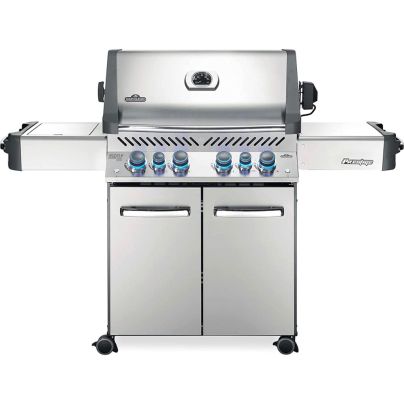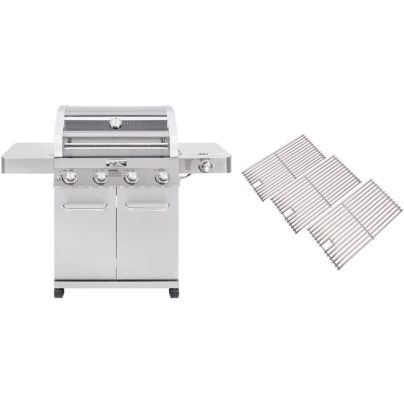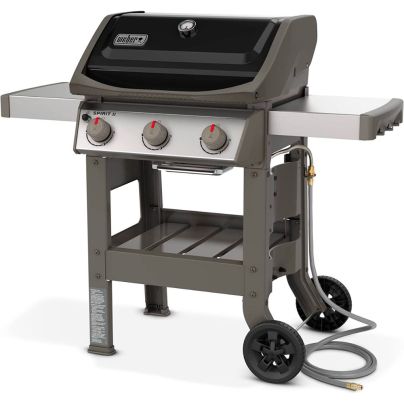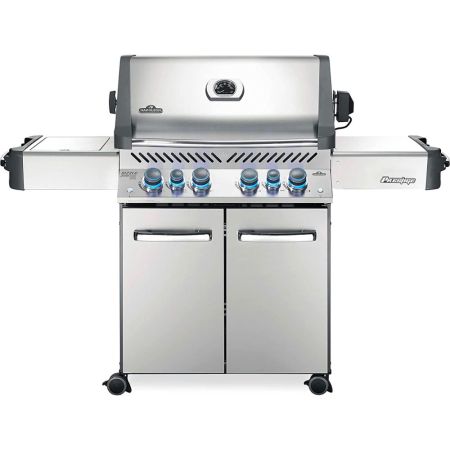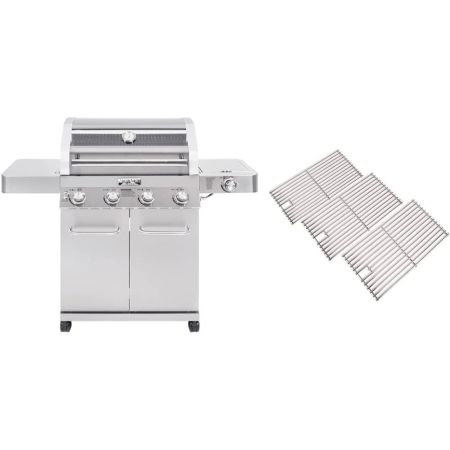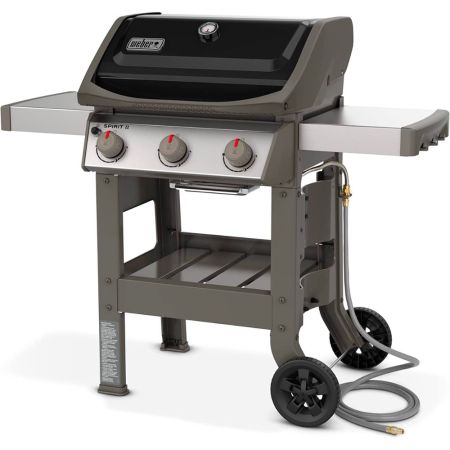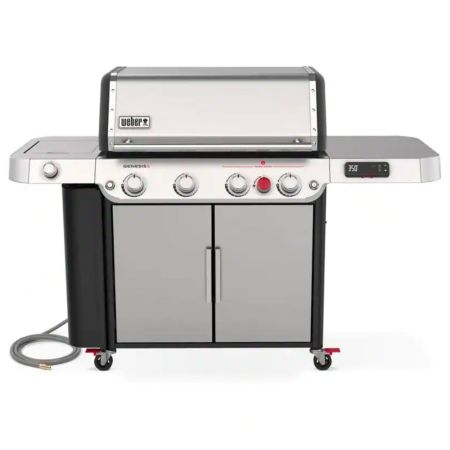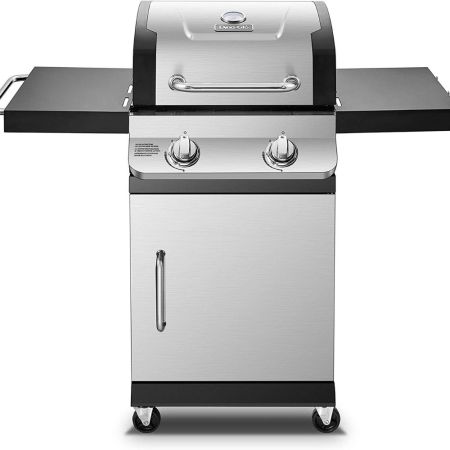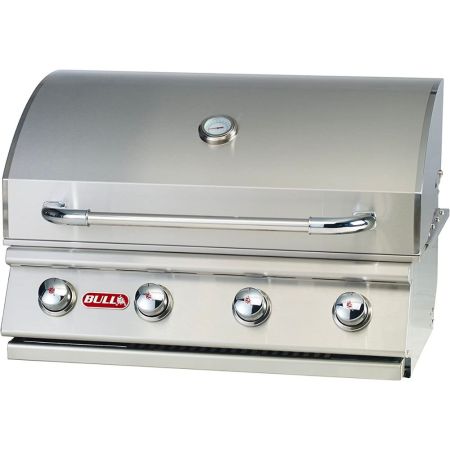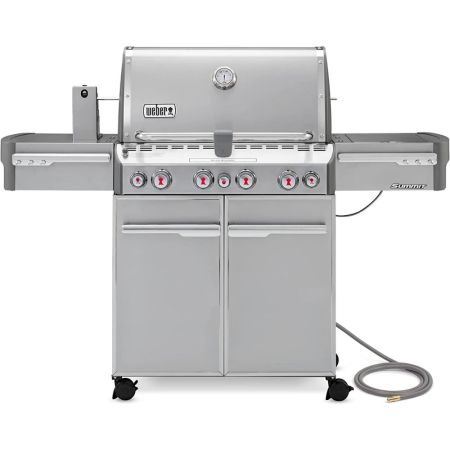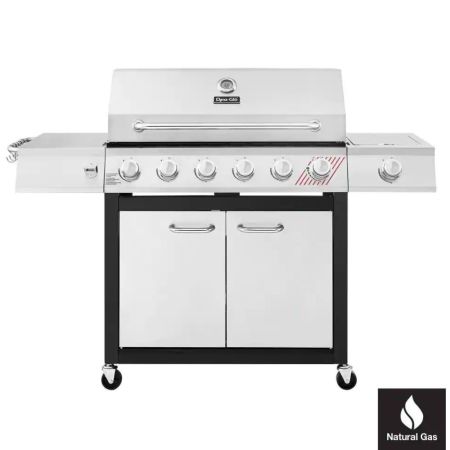We may earn revenue from the products available on this page and participate in affiliate programs. Learn More ›
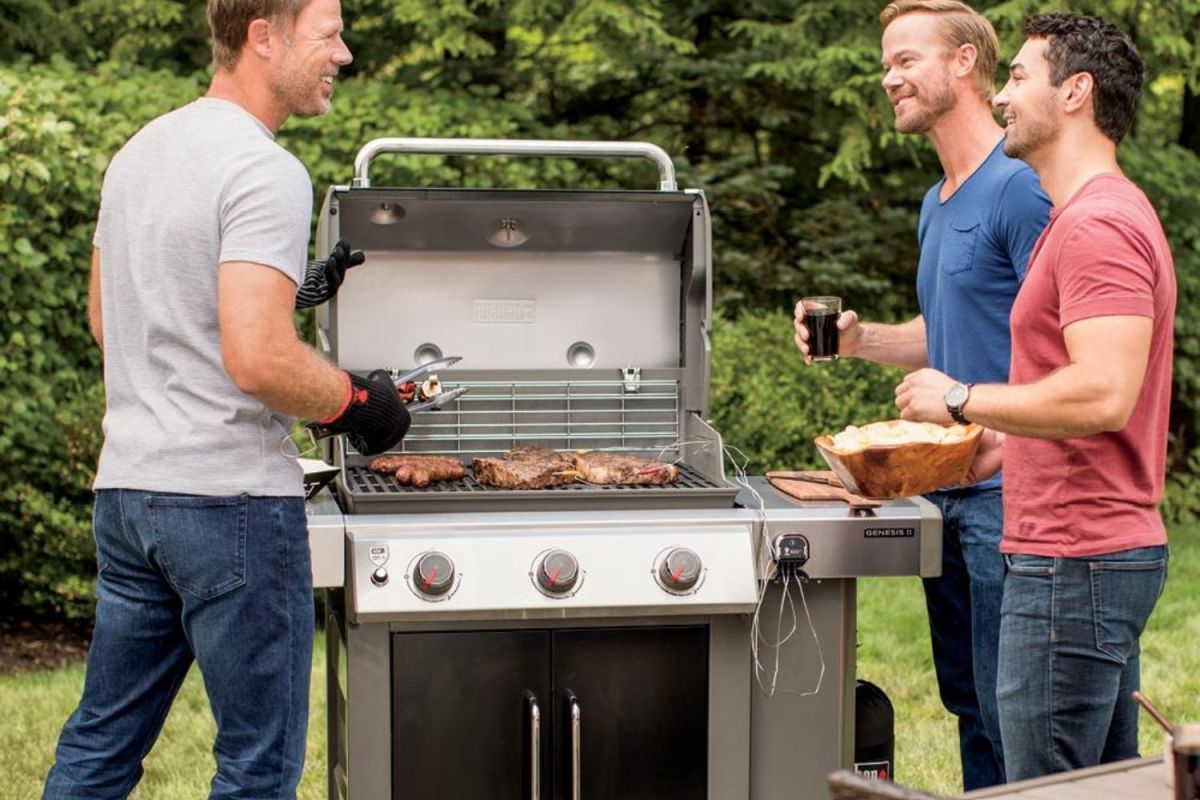
Preparing for family barbecues can be simpler with a grill that’s easy to use and clean. Natural gas grills use hydrocarbon fuel instead of charcoal or propane, making them the most eco-conscious grill type on the market.
The best natural gas grills won’t leave anyone hanging without fuel, as they tie directly into a home’s natural gas supply. Instead, they offer a constant fuel source to prevent last-minute trips to the local propane swap. In this guide, we list our top picks for some of the best natural gas grills on the market to level up the next backyard cookout.
- BEST OVERALL: Napoleon Prestige 500 RSIB Natural Gas Grill
- RUNNER-UP: Monument Grills 41847NG Propane and Natural Gas Grill
- BEST BANG FOR THE BUCK: Weber Spirit II E-310 3-Burner Natural Gas Grill
- UPGRADE PICK: Weber Genesis SPX-435 4-Burner Natural Gas Grill
- BEST COMPACT: Dyna-Glo Premier 2-Burner Natural Gas Grill
- BEST BUILT-IN: Bull Stainless Steel 4-Burner Outlaw Gas Grill Head
- BEST WITH ROTISSERIE: Weber Summit S-470 Stainless Steel Natural Gas Grill
- BEST WITH SIDE BURNER: Dyna-Glo 6-Burner Stainless Steel Natural Gas Grill
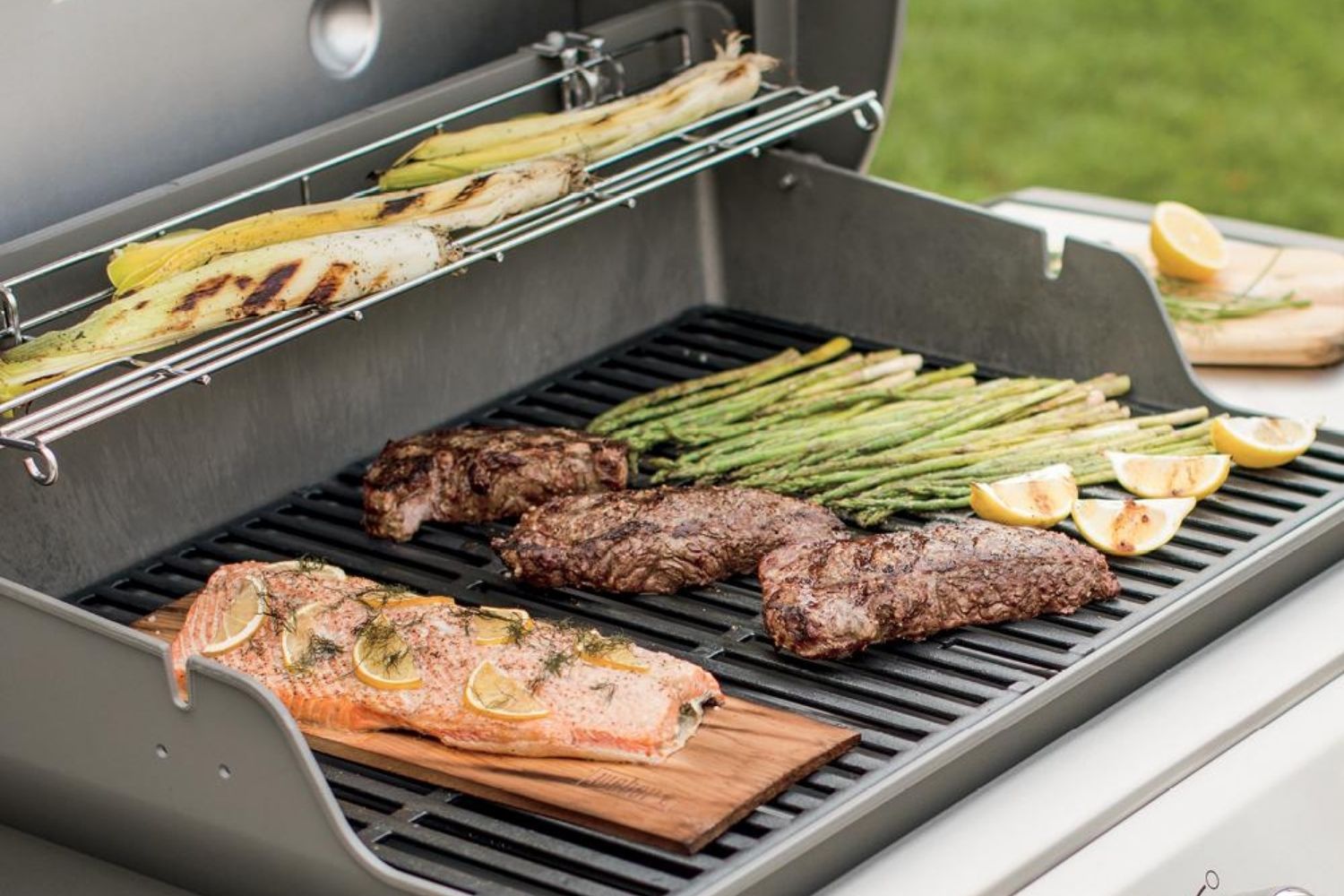
How We Chose the Best Natural Gas Grills
Natural gas grills make cooking outdoors easy, and they don’t typically run out of gas midway through food prep. With a focus on heat output and cooking space requirements, materials used, ease of space, and special features, our research led us to draw up a list of reliable models.
Our selections have durable construction and are made from stainless steel tube burners and cast iron for anticorrosion and weather resistance. These choices also have ample heat output and cooking space and can prepare 20 to 30 burgers at once with their 30,000 to 80,000 British thermal units (BTUs).
The products on our list also come with electric ignition for safety and ease of use. Some models have extras like side shelves and burners, storage cabinets, hanging hooks for tools, wheels for portability, and even Bluetooth capabilities, allowing users to monitor cooking temperatures closely for the perfect burger or steak every time.
Our Top Picks
The Bob Vila team knows how challenging shopping for a natural gas grill can be. That’s why we compiled the following list of some of the best natural gas grills on the market.
Best Overall
Napoleon Prestige 500 RSIB Natural Gas Grill
See ItWhen maximum flexibility or versatility is necessary, the Napoleon Prestige 500 RSIB natural gas grill, which has an infrared rotisserie burner as well as a rear one, might be at its best. This natural gas grill features stainless steel construction and provides 900 square inches of cooking space that includes a warming rack and side burner space. That side burner is a big deal, as it’s infrared and can heat up to 1,800 degrees Fahrenheit in 30 seconds.
This model has more to offer, as well. It provides up to 80,000 BTUs of heat output from the main burners, and those burners are controlled by LED-backlit control knobs on the front of the unit. When the burners are lit, the control knobs turn red. It also comes with an electronic ignition for fast starts, a rear burner meant to be used for an infrared rotisserie burner, and also built-in lighting. All this does come at a cost, however, as this grill tips the scales at just under 200 pounds.
Product Specs
- Burners: 4
- Power output: 80,000 BTUs
- Size: 50.25 inches tall by 66.25 inches wide by 26.50 inches deep
- Cooking surface: 900 square inches
- Weight: 196 pounds
Pros
- Infrared side burner heats up to 1,800 degrees Fahrenheit in 30 seconds for fast cooking
- LED control knobs and built-in lighting ensure that grillers can check food during nighttime grilling
- Provides up to 900 square inches of cooking space along with a warming rack
Cons
- Preheating this grill may take a bit longer than expected
- Some users say it’s difficult to align the grill’s doors properly during assembly
Get the Napoleon natural gas grill at Amazon, BBQ Guys, or Kickass Grills.
Runner-Up
Monument Grills 41847NG Propane and Natural Gas Grill
See ItNo, this isn’t cheating: The Monument Grills convertible four-burner propane and natural gas grill does belong on this list. Yes, it requires a conversion kit purchase from the manufacturer, and that is its one downside. However, it has so many other features worth considering, such as the 60,000 BTUs delivered across four stainless steel burners and one side burner. It also has a total cooking area of 723 square inches—513 square inches of cooking space and a 210-square-inch warming rack—despite coming in a relatively compact frame.
As far as additional features, the Monument has a bunch—the coolest of which is the glass window on the lid, which allows users to check on their food without opening it and losing heat and smoke. It also has integrated tool hooks, a side burner, and a large removable drip pan as opposed to a small catch can. It features an electronic ignition system as well as LED control knobs for a high-tech touch as well. The entire body is stainless steel for durability and good looks, and the grates are porcelain-coated cast iron for easy cleaning and improved heat retention over stainless.
Product Specs
- Burners: 4 main burners; 1 side burner
- Power output: 60,000 BTUs
- Size: 46.3 inches tall by 54.1 inches wide by 19 inches deep
- Cooking surface: 723 square inches
- Weight: 101.4 pounds
Pros
- Glass window on lid provides food visibility without a need to open it, retaining heat
- Integrated tool hooks, side burner, electronic ignition system, and LED control knobs are all included
- 4 burners and 1 side burner provide 723 square inches of total cooking space
Cons
- Users will have to purchase the natural gas conversion kit from the Monument Grills website
Get the Monument Grills natural gas grill at Amazon, Lowe’s, Target, Wayfair, or The Home Depot.
Best Bang for the Buck
Weber Spirit II E-310 3-Burner Natural Gas Grill
See ItGrilling a delicious meal doesn’t always require the most expensive tools. The Weber Spirit II E-310 three-burner natural gas grill has features similar to grills that are twice the size. This grill has three stainless steel burners capable of producing 30,000 BTUs of heat, porcelain-enameled (and reversible) cast-iron cooking grates, and folding side shelves. It comes with a built-in port for the iGrill 3 meat thermometer—a feature most high-tech grillers appreciate.
The grill’s lid and body are painted steel; though not the most durable material, it does keep the price and weight down. If corrosion is a concern, rolling the 114-pound grill inside for winter storage is easy thanks to its large wheels. And, while compact is good, this might be a bit small for a large family.
Read our full review:Weber Spirit II E-310 3-Burner Natural Gas GrillProduct Specs
- Burners: 3
- Power output: 30,000 BTUs
- Size: 44.5 inches tall by 52 inches wide by 27 inches deep
- Cooking surface: 529 square inches
- Weight: 114 pounds
Pros
- Compatible with iGrill 3 meat thermometer; lets users track food preparation with their smartphones
- Light enough to roll into the garage for winter storage or keep small patios clear
- Porcelain-enameled cast-iron grates allow for better rust and corrosion resistance
Cons
- It’s likely too small to cook enough food for the entire family at once
Get the Weber Spirit II natural gas grill at Amazon, Ace Hardware, The Home Depot, or Weber.
Upgrade Pick
Weber Genesis SPX-435 4-Burner Natural Gas Grill
See ItWhen it comes to grills, there aren’t many as advanced as the Weber Genesis SPX-435. This model features Weber’s smart technology, Weber Connect, which provides users with real-time food temperature alerts, reminders, and flip and serve notifications to the user’s phone. That may be a serious benefit to some folks, as the SPX-435 offers up to 994 square inches of cooking space, allowing users to grill a few tomahawk steaks, burgers, and dogs at a time.
The Weber Genesis features four 12,000-BTU burners offering a total of 48,000 BTUs. That may be slightly undersized for such a large grill, but this model’s additional features might make up for it. It has all stainless steel construction and a side burner, and it comes with a cabinet on the side to store accessories. It also has a motion-activated lighting system that illuminates the side tables and grill surfaces so users can see at night.
Product Specs
- Burners: 4
- Power output: 48,000 BTUs
- Size: 48.5 inches tall by 68.5 inches wide by 27 inches deep
- Cooking surface: 994 square inches
- Weight: 188 pounds
Pros
- Weber Connect app alerts grillers about cooking temperatures, timers, and fuel levels through their smartphones
- Provides up to 994 square inches of cooking area for preparing large meals quickly
- Side cabinet provides a handy, safe area for storing accessories and grilling tools
- Built-in lighting system is motion activated; can illuminate cooking area and side tables at night
Cons
- 48,000 BTUs overall might be slightly underpowered for the amount of cooking space
Get the Weber Genesis natural gas grill at The Home Depot, Lowe’s, or Weber.
Best Compact
Dyna-Glo Premier 2-Burner Natural Gas Grill
See ItFolks who just want to add a grill that takes advantage of their natural gas supply without breaking the bank might find this model to be a great fit. The Dyna-Glo Premier two-burner natural gas grill offers a compact, lightweight grill with an affordable price tag, giving users a bit more outdoor cooking flexibility.
This affordable grill’s price tag is its shiny attribute, but it has other benefits to offer as well. For example, the body consists of a lot of stainless steel, including the lid, control panel, and cabinet door. Also, the grates are cast iron, making them durable but also allowing for even heat distribution. It does have just 445 square inches of total cooking space, but the 24,000-BTU burners should handle meals for a small family or group of friends.
Product Specs
- Burners: 2
- Power output: 24,000 BTUs
- Size: 45.28 inches tall by 50.2 inches wide by 23.23 inches deep
- Cooking surface: 445 square inches
- Weight: 90 pounds
Pros
- Affordable; folks can use natural gas piped to their house without a big investment
- Compact, lightweight design provides some flexibility when it comes to storage or placement
- Stainless steel parts and cast-iron grates help it last for longer than painted steel alone
Cons
- Relatively small cooking area can’t handle large gatherings; should be sufficient for small gatherings
Get the Dyna-Glo Premier natural gas grill at Amazon.
Best Built-In
Bull Stainless Steel 4-Burner Outlaw Gas Grill Head
See ItThe drop-in design of Bull’s Outlaw gas grill head makes it easy to incorporate into an outdoor kitchen. At 21.25 inches tall, this grill’s measurements (31 inches wide by 25.25 inches deep) fit most standard-size grill cutouts, so no custom planning is required. The Outlaw gas grill head is also packed with desirable features like an 810-square-inch cooking surface and four porcelain-coated bar burners for even heat distribution across the entire cooking surface.
The stainless steel grates, base, and hood make this grill durable enough for the rigors of an outdoor kitchen. Piezo igniters, similar to those on kitchen stoves, along with zinc control knobs and burners that produce up to 60,000 BTUs add functionality and durability. However, this grill only works in outdoor kitchens—it doesn’t come with a stand or legs.
Product Specs
- Burners: 4
- Power output: 60,000 BTUs
- Size: 21.25 inches tall by 31 inches wide by 25.25 inches deep
- Cooking surface: 810 square inches
- Weight: 130 pounds
Pros
- Stainless steel construction for both body and grates means long-lasting corrosion resistance
- Fits standard outdoor kitchen cutouts so heavy modifications shouldn’t be necessary
- Porcelain-coated burners will last longer and prevent rust better than untreated burners
Cons
- Designed for outdoor kitchens with cutouts, so it won’t work as a stand-alone grill
Get the Bull natural gas grill at Amazon, BBQ Guys, or Kickass Grills.
Best with Rotisserie
Weber Summit S-470 Stainless Steel Natural Gas Grill
See ItOne of the best ways to get the most out of a natural gas grill is to find one compatible with a rotisserie. Weber’s Summit S-470 checks the boxes thanks to its rotisserie feature. Simply pop the rotisserie up and turn the motor on to enjoy roasted meats and veggies.
This grill features an output of 48,800 BTUs between four stainless steel burners with stainless steel cooking grates overtop.
The total cooking space is 580 inches. There is also a side burner, a sear station burner, a smoker burner, and an infrared rotisserie burner, which combined produce an additional 40,000 BTUs of heat. All these features do come at a cost, as it is a bit expensive for a grill and quite heavy (well over 200 pounds). However, the stainless steel body and the ability to smoke, grill, sear, and roast might make up for it.
Product Specs
- Burners: 4 main burners; 1 side burner; 1 smoke box; 1 sear station; 1 rotisserie burner
- Power output: 48,800 BTUs between 4 main burners; 12,000 BTUs side burner; 6,800 BTUs smoke box; 10,600 BTUs sear station; 10,600 infrared rotisserie burner
- Size: 50.5 inches tall by 66 inches wide by 30 inches deep
- Cooking surface: 580 square inches
- Weight: 235 pounds
Pros
- Built-in pop-up rotisserie makes roasting meat easy and convenient
- Can smoke, grill, sear, or roast meat for maximum food prep capability
- Stainless steel construction helps it withstand the conditions and remain corrosion-free
Cons
- It’s well over 200 pounds, so winter storage could be a challenge
Get the Weber Summit natural gas grill at Amazon, Lowe’s, The Home Depot, or Weber.
Best with Side Burner
Dyna-Glo 6-Burner Stainless Steel Natural Gas Grill
See ItFolks looking to bring the steakhouse flavor home will want to check out Dyna-Glo’s six-burner natural gas grill. This freestanding stainless steel grill offers plenty of space and capability to handle most grilling needs. Its six main burners and one side burner produce a combined 77,000 BTUs of heat, providing plenty of power. The main cooking space measures 566 square inches, but the total cooking area is 805 square inches (including the top warming rack and side burner).
This model has all types of built-in features that shoppers should consider. First, it has a sear zone with a porcelain-coated diamond-patterned cast-iron grate for getting that ideal sear on a steak (the other grates are porcelain coated, as well). It also has a removable smoker burner box that fits between two grills for additional flavor. It comes with a cast-iron griddle as well as an integrated electronic ignition system, LED-lit control knobs, a towel bar, tool hooks, and a bottle opener. While the base is painted steel, the rest is either stainless or cast iron.
Product Specs
- Burners: 6 main burners; 1 side burner
- Power output: 77,000 BTUs
- Size: 47.23 inches tall by 63.65 inches wide by 22.42 inches deep
- Cooking surface: 805 square inches
- Weight: 149.78 pounds
Pros
- Features a sear station, special diamond-patterned grate, and a removable smoker box for added flavor
- Comes with a large 224-square-inch cast-iron griddle, LED control knobs, and integrated hooks
- 805-square-inch cooking space offers plenty of room for grilling, smoking, and searing
- Mainly stainless steel and cast-iron construction for long-term corrosion resistance
Cons
- Mostly made of stainless steel, but painted base may not be as durable
Get the Dyna-Glo stainless steel natural gas grill at The Home Depot.
Jump to Our Top Picks
What to Consider When Choosing the Best Natural Gas Grill
The best natural gas grills aren’t so different from traditional gas grills. They’re light in a similar manner and are just as easy to maintain and use. Here are a few important points shoppers may want to consider before buying a natural gas grill.
Freestanding vs. Built-In
There are two main types of natural gas grills: freestanding and built-in. Which of the two will work best is largely a personal preference.
- Freestanding natural gas grills stand on their own, similar to a basic gas or charcoal grill. Some have cabinets underneath for storing items or hiding the natural gas line. A freestanding grill can be placed anywhere a natural gas line will reach. They are typically less expensive than a built-in grill and are easy to store away in the winter.
- Built-in natural gas grills are designed to slide into a nook meant specifically for a grill. The best outdoor built-in grill is a natural choice for an outdoor kitchen where appliances can be added as part of the open-air room’s design. The cooking area is not necessarily smaller than a freestanding grill, and legless built-in grills create a more seamless look than with a freestanding grill.
Material and Construction
The bodies, legs, and lids of grills are usually made of either stainless steel or standard painted steel.
- Stainless steel is the most durable material. It’s corrosion-resistant, long lasting, and easy to clean, but it’s also expensive and heavy.
- Painted steel is lighter and less expensive, but it might not last as long due to corrosion.
Grill grates are usually made of stainless steel, porcelain- or ceramic-coated cast iron, or cast iron.
- Stainless steel grates are easier to clean and lighter than cast iron. They heat up faster but don’t retain heat as well.
- Cast-iron grill grates retain heat well, offering a cooking surface with a consistent temperature, but they are more likely to corrode.
- Coated cast-iron grates offer the best of both worlds, but the ceramic or porcelain coating can chip, resulting in rusting.
Size and Weight
Size and weight aren’t much of a concern for the best outdoor built-in grills, but those factors do matter for freestanding models folks need to move around. Striking the right balance between work-surface size and portability is key.
A compact natural gas grill may weigh 80 or 90 pounds, while a larger stainless steel grill can weigh more than 250 pounds. Most freestanding grills have wheels built in to make it fairly easy to move them around the patio or into the garage for winter storage.
Many grill manufacturers use the number of burgers that will fit on their grills’ cooking surfaces at one time to determine size. A larger grill might fit 30 or more burgers and measure more than 5 feet across (including the side wings). A compact grill might fit 18 or 20 burgers and measure less than 3 feet across.
Cooking Surface
There’s more to a grill’s cooking surface than the number of burgers it can hold. Shoppers should also consider the number of burners the grill has and whether it has side burners, a warming rack, and more.
A compact or smaller grill will usually have enough room to cook a handful of burgers and hot dogs as well as a warming rack for heating bread. These grills generally offer around 400 square inches of cooking surface, two burners, and a small prep surface on either side of the grill.
Large grills can offer 700 to 900 square inches of cooking surface and hold enough burgers, hot dogs, chicken wings, and steaks for a crowd. Since not all of those meats cook at the same temperature, large grills usually have several adjustable burners. These grills often have additional cooking surfaces like side burners for pans.
Heating Output
Natural gas does not provide as high a temperature as propane does, so it’s important to consider heat output. When manufacturers design a natural gas grill, they use larger jets (or oil burner nozzles) to allow more natural gas to flow through than would be typical for a propane grill. This increased volume compensates for the lower-burning temperature.
Manufacturers describe the heat output of their grills with BTUs. The higher the BTUs, the greater the heat output. Proper heat output is relative to the size of the grill. A smaller grill will have fewer burners, producing (but also requiring) less heat. A larger grill with 45,000 or more BTUs heats quickly while also providing even heat across its entire cooking surface. A smaller grill with 20,000 to 30,000 BTUs will do the same.
Additional Features
For convenience, the best natural gas grills include features such as electronic igniter switches and thermometers for monitoring the grill temperature. Some even feature built-in Bluetooth compatibility and can accept digital meat thermometers that transmit the internal temperature of a piece of meat directly to a mobile device.
Additional work space and extra burners are also worth noting. Some of the best natural gas grills have folding side wings that offer a wide surface for placing platters while cooking but then drop down for easy storage. They also have burners for heating sauerkraut, pan-frying onions and peppers, and cooking other types of foods.
Ease of Cleaning
Natural gas grills are just as easy to clean as propane grills. To minimize messes, they have built-in grease catchers underneath. Stainless steel is by far the easiest material to clean and maintain, with porcelain- or ceramic-coated cast iron coming in second place.
Cast iron is a little more difficult to clean and requires a coat of oil to stay rust-free. Soap and water are suitable for cleaning any of these materials, but a grill cleaner might do a better job. Users can also crank up the burners to heat them and then brush them clean between regular cleanings. It can help to add a grill cover to make sure it stays clean in all sorts of weather.
FAQs
Shoppers who are new to grilling with natural gas may still have some questions about finding the best natural grills for their homes. Here are our answers to some of the most commonly asked questions about natural gas grills.
Q. Is it safe to grill with natural gas?
Yes, grilling with natural gas is just as safe as grilling with propane. But propane should never be used in a natural gas grill. The valves and nozzles in natural gas grills are larger, and they can emit too much propane to be used safely. Luckily, the hose fittings should prevent this from accidentally occurring, but this is still an important distinction to understand.
Q. Is natural gas better than propane for grilling?
Not necessarily. Natural gas doesn’t burn as hot, and many gas-grilling purists actually prefer propane grills. That said, folks with natural gas plumbed into their homes can take advantage of it by installing a natural gas grill. This means they’re less likely to run out of gas while cooking and they don’t have to make trips to the gas station or hardware store for a tank exchange.
Q. How do I choose a natural gas grill?
When choosing a natural gas grill, shoppers should start by considering the materials used. Cheaper grills made from coated steel can rust over time. Features and extras, like burner count, electronic ignition, side burners, and rotisseries, are also important considerations. Some models now include advanced features like LED control knobs, built-in lighting, and smart devices that monitor food temperatures and send updates to a phone.
Q. Can any gas grill be converted to natural gas?
No. Propane grills have smaller valves and orifices, so they won’t emit enough natural gas to reach proper cooking temperatures. However, some grills do work with conversion kits. They come with properly sized jets and fittings, allowing users to swap their propane grill over to natural gas. It’s a good idea to contact the manufacturer to ask if a grill can convert.
Q. How long do natural gas grills last?
The average natural gas grill lasts 5 to 15 years, but it needs to be well maintained. Proper cleaning, winter storage, and a cover will help a gas grill last as long as possible. The same is true for propane grills, as long as they’re both made from quality materials and taken care of. If not, they can last less than 5 years before the grill body starts to fail.
Why Trust Bob Vila
Bob Vila has been America’s Handyman since 1979. As the host of beloved and groundbreaking TV series including “This Old House” and “Bob Vila’s Home Again,” he popularized and became synonymous with “do-it-yourself” home improvement.
Over the course of his decades-long career, Bob Vila has helped millions of people build, renovate, repair, and live better each day—a tradition that continues today with expert yet accessible home advice. The Bob Vila team distills need-to-know information into project tutorials, maintenance guides, tool 101s, and more. These home and garden experts then thoroughly research, vet, and recommend products that support homeowners, renters, DIYers, and professionals in their to-do lists.
